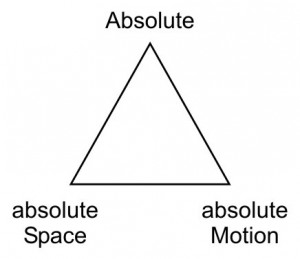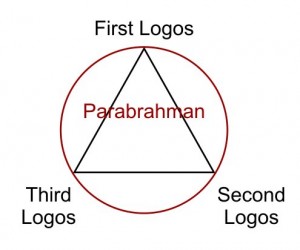In the summary in SD I, 16, a clearer idea of is given of the subject of the first fundamental proposition. This proposition is stating an “Omnipresent, Eternal, Boundless, and Immutable PRINCIPLE”. The summary is meant as a clarification of the text in SD I, 14-16 under (a).
The following summary will afford a clearer idea to the reader.
(1.) The ABSOLUTE; the Parabrahm of the Vedantins or the one Reality, SAT, which is, as Hegel says, both Absolute Being and Non-Being.
The Absolute, Parabrahman.
(2.) The first manifestation, the impersonal, and, in philosophy, unmanifested Logos, the precursor of the “manifested.” This is the “First Cause,” the “Unconscious” of European Pantheists.
The unmanifested Logos, which is apparently different from the Absolute here. We have called this the First Logos. (see The Three Logoi)
(3.) Spirit-matter, LIFE; the “Spirit of the Universe,” the Purusha and Prakriti, or the second Logos.
Literally the Second Logos.
(4.) Cosmic Ideation, MAHAT or Intelligence, the Universal World-Soul; the Cosmic Noumenon of Matter, the basis of the intelligent operations in and of Nature, also called MAHA-BUDDHI.
In our earlier analysis we have identified the Universal World-Soul with the Third Logos.
Confusingly, we found Mahat to correspond to the Second Logos.
The Cosmic Noumenon of Matter is mentioned as “noumenon of matter” in SD I, 84
The expanding and contracting of the Web — i.e., the world stuff or atoms — expresses here the pulsatory movement; for it is the regular contraction and expansion of the infinite and shoreless Ocean of that which we may call the noumenon of matter emanated by Swabhavat, which causes the universal vibration of atoms.
The noumenon of matter is the web
In this passage we can safely assume that “universal vibration of atoms” corresponds to “pulsatory movement”, which is apparently the “expanding and contracting of the Web”. What causes this vibration is not entirely clear from the text. Syntactically “which” could refer either to
1. the regular contraction and expansion
2. the infinite and shoreless Ocean
3. that which we may call the noumenon of matter
4. Swabhavat
Logically, it could not be 1, as the cause of vibration could not be itself. From “for it is the regular…” we can again safely conclude that by the “infinite and shoreless Ocean” is meant the Web. It could therefore not be 2, because the Web apparently does not vibrate by itself. Is the noumenon emanated or the matter? The Ocean apparently consists of the “noumenon of matter”. Therefore the Ocean is still unmanifested, and it is the noumenon that is emanated by Swabhavat, not matter. As the noumenon is itself the substance of the Ocean, Swabhavat will be the cause of its vibration. The alternative would be that the noumenon is the cause of vibration, which means that the Web vibrates because of its substance.
If we return to śloka 10 in stanza III:
AND THIS WEB IS THE UNIVERSE SPUN OUT OF THE TWO SUBSTANCES MADE IN ONE, WHICH IS SWABHAVAT
Here Swabhavat is identified with the substance of the web. Because the substance is twofold in itself, the vibration is an inherent quality of the web, as we can see from śloka 11 in stanza II:
IT (the Web) EXPANDS WHEN THE BREATH OF FIRE (the Father) IS UPON IT; IT CONTRACTS WHEN THE BREATH OF THE MOTHER (the root of Matter) TOUCHES IT.
This means both solutions 3 and 4 could be acceptable, and consequently the “Cosmic Noumenon of Matter” is the Father-Mother substance of the Web, alternatively Swabhavat. As for now it is unclear to me if this might be related to the Second, or the Third Logos.
The “basis of intelligent operations in and of Nature” might be interpreted either way, but seems closer to our idea of the Third Logos than to the Second.
As for mahabuddhi, we can sum up some other relevant passages here.
1. One location is SD I, 451:
Mahat (or Maha-Buddhi) is, with the Vaishnavas, however, divine mind in active operation, or, as Anaxagoras has it, “an ordering and disposing mind, which was the cause of all things,” — [[Nous o diakosmonte kai panton aitios]].
We identified Anaxagoras’ concept of nous as the Third logos, and also the “divine mind in active operation” is exactly what we have defined as the Third Logos. In this quote, mahat (mahabuddhi) is defined differently, not as the Second Logos but as the Third, apparently following “the Vaishnavas”.
The quote “Nous [estin] ho diakosmon te kai panton aitios” is taken from Plato’s Phaedo, 97c, “νοῦς ἐστιν ὁ διακοσμῶν τε καὶ πάντων αἴτιος“, “it is the mind that arranges and causes all things”, in the translation of Harold North Fowler.
2. A second is SD I, 572:
Esoterically the teaching differs: The divine, purely Adi-Buddhic monad manifests as the universal Buddhi (the Maha-buddhi or Mahat in Hindu philosophies) the spiritual, omniscient and omnipotent root of divine intelligence, the highest anima mundi or the Logos.
Here we have mahat (mahabuddhi) as the Second Logos, which is the Logos proper, and HPB’s Anima Mundi.
Mahat is used in different meanings, though it seems to be in a consistent way. Apparently in the summary of the first fundamental proposition, mahat is used conform SD I, 451.
Returning to the structure of the summary, it seems to be
(1) Parabrahman, the Absolute
(2) First Logos
(3) Second Logos
(4) Third Logos
If we try to put this in a diagram, instead of something like
the structure would become something like
Today I consulted the 1893 “Third Revised Edition” of The Secret Doctrine, which – fascinatingly – has a slightly altered summary text, on p. 44 (different page numbering):
(1.) Absoluteness: the Parabrahman of the Vedântins or the One Reality, Sat, […]
(2.) The First Logos: the impersonal […]
(3.) The Second Logos: Spirit-Matter […]
(4.) The Third Logos: Cosmic Ideation […]
This would mean that the Adyar edition also has this version of the summary, as it is based on the 1893 revised edition. This version of the summary does “afford a clearer idea to the reader”, as opposed to the 1888 summary…


The first Adyar Edition indeed has this same summary text. Like the 1893 Third Revised Edition, it has a page numbering different from the 1888 edition, which is why I almost never use it. In the 1993 Quest edition, which was based on the Adyar Editions, the original page numbering was restored.
Here is a link to the preface to the 1962 Adyar Edition: http://prajnaquest.fr/blog/?attachment_id=585